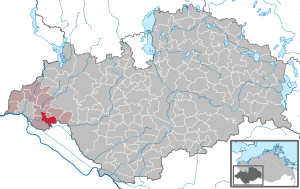Possession (Mecklenburg)
| coat of arms | Germany map | |
|---|---|---|

|
Coordinates: 53 ° 21 ' N , 10 ° 52' E |
|
| Basic data | ||
| State : | Mecklenburg-Western Pomerania | |
| County : | Ludwigslust-Parchim | |
| Office : | Boizenburg country | |
| Height : | 10 m above sea level NHN | |
| Area : | 22.27 km 2 | |
| Residents: | 445 (Dec. 31, 2019) | |
| Population density : | 20 inhabitants per km 2 | |
| Postal code : | 19258 | |
| Area code : | 038844 | |
| License plate : | LUP, HGN, LBZ, LWL, PCH, STB | |
| Community key : | 13 0 76 010 | |
| Community structure: | 2 districts | |
| Office administration address: | Fritz-Reuter-Strasse 3 19258 Boizenburg / Elbe |
|
| Website : | ||
| Mayor : | Sylke Bechump | |
| Location of the municipality property in the Ludwigslust-Parchim district | ||
Possession [ beːzɪt͡s ] is a municipality in the district of Ludwigslust-Parchim in Mecklenburg-Vorpommern (Germany). It is administered by the Boizenburg-Land Office , based in the non-official city of Boizenburg / Elbe .
The municipal area is divided into the districts of possession and Blücher.
geography
The community is located in the west of Mecklenburg-Western Pomerania. The Sude and the Schaale flow through the municipality . The federal highway 5 and the Hamburg – Berlin railway line run about four kilometers north of possession. The nearest train station is in the neighboring community of Brahlstorf .
history
Property was first mentioned in a document in 1376. The name comes from the Old Slavic brŭtĭ for beehive and means something like beehive place .
Finds, including from the Neolithic and Bronze Age , prove that the area was settled much earlier. Between the castle lake and the river Sude, the castle complex Nedderborg , which has not been preserved and which is still known as a field name , was built during the Slav period . Around 1500 there were around 17 Hufen and eight Katen in the village , one of which was a jug and one was a forge. In 1496 115 inhabitants lived in possession. The place suffered from the Thirty Years' War , which brought about 20 percent loss of population and devastation.
Tradition has it that the residents have always had to deal with floods. The first regulations on the Sude in the backwater area of the Elbe , which were intended to reduce the risk of flooding, took place around 1830.
Blücher is a former manor village and was first mentioned in a document with the name Bluggere in 1230 in the Ratzeburg tithe register . The estate is considered the ancestral seat of the formerly Slavic noble family von Blücher . The estate goes back to an old castle (12th / 13th century), the moat is still there today. The baroque manor house was built in 1703 using building materials from the renaissance castle Neuhaus / Elbe, which was demolished in 1690. It was acquired by Major Victor von Zülow from the von Dehn family in Hanover in 1702 .
The neo-Gothic village church of Blücher dates from 1876 as a successor to an old church.
politics
Coat of arms, flag, official seal
The municipality has no officially approved national emblem, neither a coat of arms nor a flag. The official seal is the small state seal with the coat of arms of the state of Mecklenburg. It shows a looking bull's head with torn off neck fur and crown and the inscription “GEMEINDE BESITZ • LANDKREIS LUDWIGSLUST-PARCHIM”.
Attractions
→ See also list of monuments owned (Mecklenburg)
- Neo-Gothic village church from 1876 in Blücher as a successor to an old church; Late renaissance altarpiece in the sacristy.
- Baroque manor house in Blücher from 1703 with medium risalit and hipped roof according to plans by Johann Caspar Borchmann for Major Victor von Zülow ; Classicist renovation from 1824. In the Middle Ages, the estate was the eponymous seat of the von Blücher family .
Web links
Individual evidence
- ↑ Statistisches Amt MV - population status of the districts, offices and municipalities 2019 (XLS file) (official population figures in the update of the 2011 census) ( help ).
- ↑ § 1 of the main statute (PDF; 3.1 MB) of the municipality.
- ^ Paul Kühnel: The Slavic place names in Meklenburg . In: Yearbooks of the Association for Meklenburg History and Antiquity . Yearbooks of history. tape 46 , 1881, ISSN 0259-7772 , p. 25 ( online [accessed July 29, 2015]).
- ↑ Dmitri Nikolajewitsch Jegorow : The colonization of Mecklenburg in the 13th century. Volume 2: The process of colonization (= library of historical works from the literatures of Eastern Europe. Vol. 1, 2, ZDB -ID 1133710-2 ). Priebatsch, Breslau 1930, p. 431.
- ↑ Blücher. In: Torsten Pöschk: “Here is my own reason; who died to me ... “The design of baroque manor houses, courtyards and gardens of the aristocracy in Mecklenburg-Schwerin in the context of the internal power conflict in the 18th century. 1st, new edition. Books on Demand, Norderstedt 2011, ISBN 978-3-8423-7436-2 , p. 65 .
- ↑ Main Statute, Section 2, Paragraph 3






